At OrthoSmile, we believe that dental implants are the best possible solution for missing teeth available today. To have a functioning set of teeth can greatly improve your quality of life. Not only will you be able to eat well, but you can also look great. Having your teeth helps give shape and support to your whole face. When teeth are lost, the gum and jaw bones shrink, which gives rise to a premature aging effect. Dental implants are made from titanium that is coated with a special coating that encourages the bone to grow around it. Once the implant integrates into the bone (osseointegration) the implant can last a lifetime. The implant is then restored with a porcelain crown, just like a tooth would be. Unlike a bridge, implants replace a missing tooth without compromising the two teeth on either side of the space by crowning them. Implants are a predictable, conservative, and aesthetic approach for tooth replacement. They are incredibly strong which means that you can bite and chew with an implant just as well as with natural teeth. They are very long-lasting, and allow you to live as if you had all of your natural teeth. Implants are also very versatile, and a combination of one or more implants can be used to restore anyone's smile to brilliance.
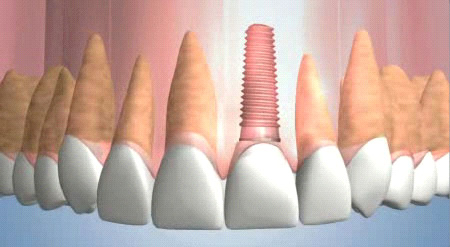
Please visit us for a consultation with our dental implantologists, Dr. Ken Kasidis, to discuss your dental implant options. We do a lot of implant dentistry and make beautiful results happen where there was a missing or broken tooth. Come in and see some of our recent work using dental implant technology.
Implants consist of small titanium posts which are placed into the jawbone where teeth are missing. The bone bonds with the titanium, creating a strong foundation for artificial teeth. In addition to restoring natural appearance in the mouth, implants can help preserve facial structure, preventing bone deterioration, which typically occurs when teeth are missing.
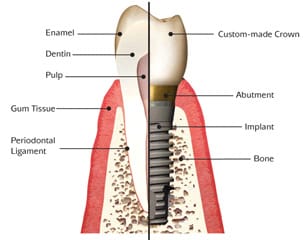
The main component is the titanium implant itself. This resembles a precisely manufactured screw with a specially roughened surface which makes it very compatible with bone. The implant is about the same size as the root of a natural tooth. It is placed into the bone and left to integrate for 4-6 weeks. By this time it is rock-solid in the bone. There are no problems with the integration of the implant into the bone, because titanium is one of the few materials that can perform osseointegration, whereby the implant is accepted into the bone which fuses around it. Once the implant is solid in the bone, the second part, a special titanium post, can be screwed into the implant. This is called the abutment. The abutment allows the fixation of the final part of the implant – the crown (a replacement tooth). The crown is usually screwed into place. The porcelain on the crown is custom made to match the color of the rest of your teeth, so that the implants are imperceptible from natural teeth.
The Benefits of Dental Implants
Choosing dental implants as a treatment option can offer you a number of significant advantages.
Dental implants can be used in almost any situation to provide the strongest possible platform for the replacement of missing teeth. Here are a few common situations where dental implants can help to restore your smile
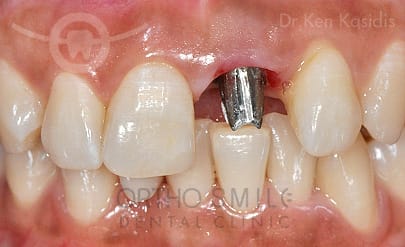
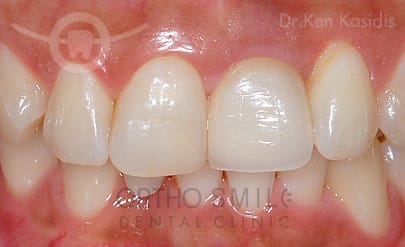
See more implant patient case examples from our case gallery
Implants are so strong that they can be used to permanently replace your bridge.

See more implant patient case examples from our case gallery
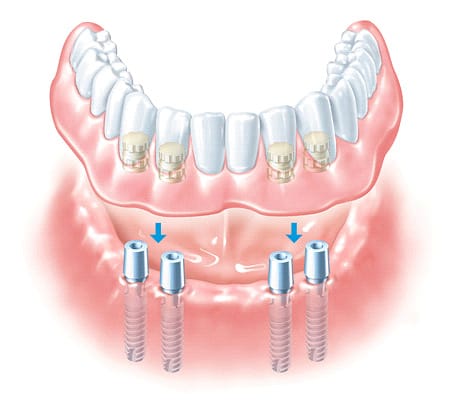

This lady came with a very loose upper and lower denture. Four implants were used to fix her lower. Any denture, big or small, can now be replaced with dental implants. This will allow you to chew all of your favourite foods with no food escaping under the denture.
See more implant patient case examples from our case gallery
If existing teeth are becoming a liability and your dentist is unable to reliably fix the problem, many patients are now choosing to have the problem tooth carefully removed and replaced with a much more reliable and stronger dental implant

See more implant patient case examples from our case gallery
Extensive rehabilitation of an aesthetically challenging case with advanced periodontal disease, failing teeth and bone loss.
This gentleman presented with advanced periodontal disease and requested an aesthetic restoration of his mouth. He had already suffered some tooth loss and all of his remaining maxillary teeth were very mobile with advanced bone loss around most of the teeth in the upper jaw and posterior teeth in the lower jaw.
Extraction of his hopeless teeth, placement of implants, bilateral sinus lifts and bone grafts and a full upper and partial lower restoration was carried out along with thorough periodontal treatment.
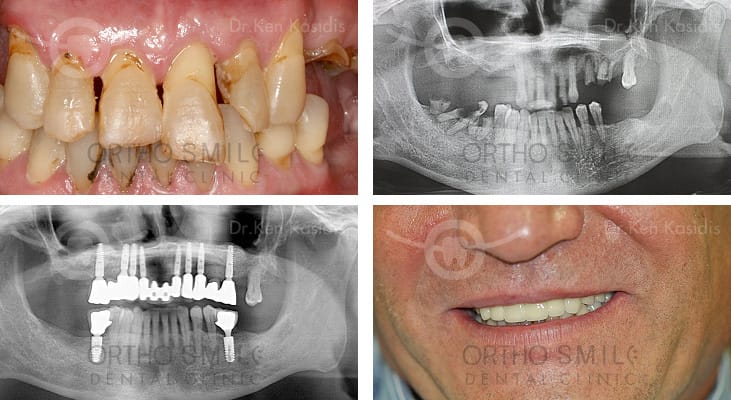
See more implant patient case examples from our case gallery
Each year, hundreds of thousands of people all around the world benefit from dental implant therapy, from children in their early years to adults in their nineties. According to The American Academy of Periodontology, "The ideal candidate for a dental implant is in good general and oral health. Adequate bone in your jaw is needed to support the important, and the best candidates have healthy gum tissues that are free from periodontal disease.
Your dentist will evaluate various factors to determine if you're a candidate for dental implants. Those factors may include certain health conditions (e.g., uncontrolled diabetes) or risk factors (e.g., smoking). These types of conditions may not rule out dental implants, but they must be taken into consideration to be sure they will not compromise successful implant therapy.
One important factor affecting implant therapy is the density of your jaw bone, which can vary in density from very dense (ideal) to very porous or spongy. Less-than-ideal bone dentistry does not necessarily prevent having dental implants, but it will likely affect your treatment plan.
No. Any person at any age can have dental implants as long as there is enough bone available in which to place the dental implants. If there is not enough bone, extra bone can often be grafted.
We understand it can be embarrassing for patients to be without their teeth. During the treatment we will ensure that you will always smile confidently and that nobody will know you have a gap.
We work closely with our patients to ensure that they feel no discomfort during the placement of the dental implant. This is through using an effective local anaesthetic. Post-operatively we supply painkillers to ensure that our patients remain comfortable. We also offer Sedation if you want to know nothing about your treatment.
For routine cases treatment time is usually ten weeks. More complex cases can take longer. For instance, when there is sufficient bone, treatment time is shortened and when there is insufficient bone, treatment time can be increased. Your specific treatment schedule will be explained to you during your consultation.
Yes. As part of our consultation we will screen your gums and bone for any infections. Prior to implant placement your remaining teeth and gums need to be healthy.
Some of our patients prefer to have the dental implants placed under sedation. A sedative can be carefully administered to relax you during the treatment, and ensure that you remember nothing about it afterwards.
Bone growth should be completed at the time of implant placement. It can be assumed that this is complete by about the age of 18 years. Girls generally finish growing earlier than boys. In case of doubt the state of the bone can be checked by an x-ray examination of the carpal bones.
It is never too late to improve your quality of life with implants. The treatment is so low-risk that implants can be placed in patients aged 70, 80 or even 90 years. There is no upper age limit. If you are fit for any other routine dental treatment and you are in good health, you can also have implants.
No, don't worry about it. Implants are not magnetic and they are also much too small to trigger the detector. And if the detector ever does beep at your implants, you will have your implant pass that will explain the problem quickly and easily.
Dental implants have been available for more than 40 years. Over this long period no allergies to titanium implants have become known. Titanium has no allergenic components and is completely neutral in the body. Of the materials used for crowns and bridges ceramic has proven the most compatibility to the body. The allergy risks vary for metals and plastics. Let your dentist advise you what material is best for you.
No. Local anesthetic can completely prevent any pain. When the dentist prepares the implant site in the bone and place the implant in, you will feel vibration and a slight pressure but no pain. For most patients the procedure feels like a normal treatment for caries, which is also conducted under local anesthetic. However, if you still want to „sleep“ during the treatment the dentist can explain the implications of general anesthetic.

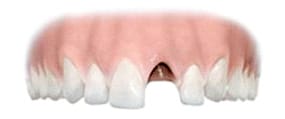

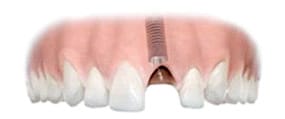

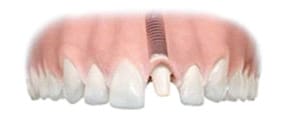

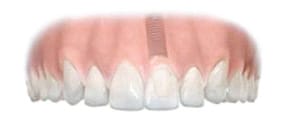
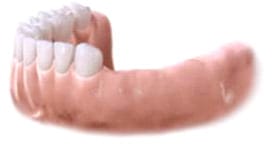

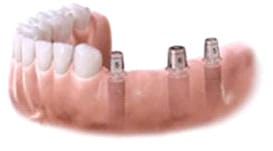

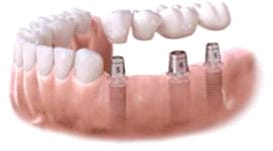

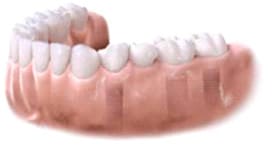

If all of your teeth are missing in the upper or lower jaw, dental implants are the best solution. You can choose a full bridge that is attached to several dental implants. Another option is a removable prosthesis that is attached via anchoring devices to two or more dental implants. The prosthesis remains securely in place in your mouth – yet it is easy to remove.
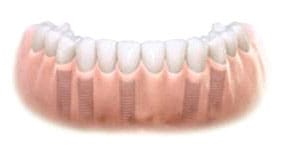
There are two options for dental implant placement depending on your clinical situation. In a one-step procedure, the dental implant is put in place and a temporary abutment is attached. In a two-step procedure, the dental implant is inserted and then covered by the gum. The abutment is attached at a later date.
In both cases, a temporary tooth or prosthesis is put in place, followed by a maximum healing period of three months for the lower jaw, and six months for the upper jaw. In some cases, the dental implant can be loaded immediately although this depends on your bone condition.
In a one-step procedure, the temporary abutment is replaced by a permanent one after the dental implant has bonded with the bone tissue. The second part of a two-step procedure involves making a minor incision to open the gum and put the abutment in place.
When the abutment is in place, a new impression is made. It is then compared with the impression made during the initial examination. Based on a final model, a dental technician carefully crafts the crown, bridge or prosthesis. Special attention is given to ensuring the right color and shape so that your new teeth look like your natural teeth.
When the teeth are ready, your dental professional simply attaches them to the dental implants. This is usually followed by a few follow-up visits to check functionality and esthetics and to make sure you are completely satisfied with your new teeth.
When you are ready for a dental implant, you will have a solution tailored to your needs, general state of health and the quantity and quality of your bone tissue. These factors also determine the total duration of the treatment. Consult your dental professional for advice on your specific options.

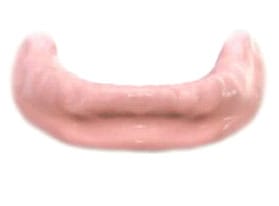

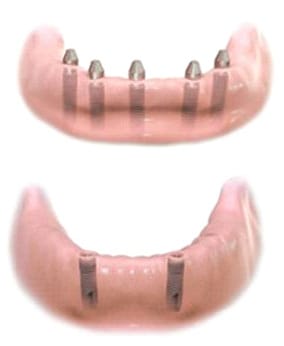

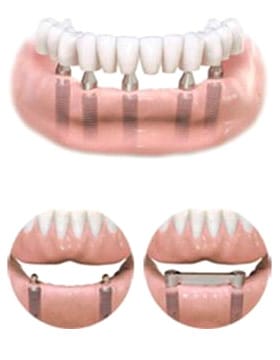

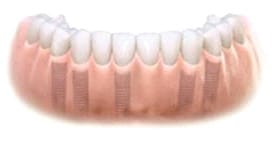

Dentsply Friadent is a company that has been providing top quality implant products to patients across the world for 30 years. The company attended a research programme in Germany in 1974 in order to develop the skills to create a ceramic implant, including the Ankylos implants. Ankylos implants are known for their top mechanical and predictable stability. Ankylos is the most authoritative system, strong and designed for long-term stability. The Ankylos connection principle, clinically proven for decades, is designed for initial and long-term tissue stability. The extremely accurate TissueCare Connection has virtually no micromovement and is almost totally bacteria-proof. And it is also keyed and friction-locked to prevent bone resorption and to ensure stable and healthy soft tissue.
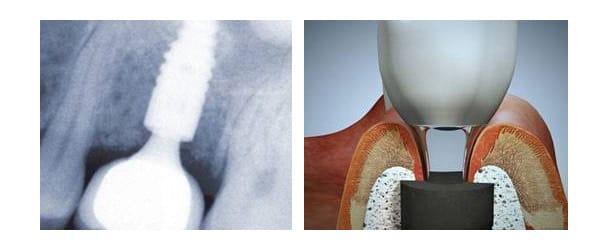
The unique TissueCare Connection transfers the transition between implant and abutment to the interior of the implant and prevents mechanical influences on it and microbial attack on the peri-implant tissue. It provides additional space for the surrounding soft tissue. The keyed principle allows subcrestal placement, and the microstructured implant shoulder makes deposition of bone cells easy - for additional support of the overlying soft tissue. ANKYLOS establishes the best conditions. The progressive thread design makes it easy to screw the implants into position and enhances tissue retention. With the keyed and friction-locked TissueCare Connection Ankylos acts as a single-component implant with all the advantages of the two-component implant: surgery and prosthetics are completely independent of each other. And it also has only one diameter for all prosthetic components: any abutment can be combined with any implant as desired. It requires less storage. It is economical and it gives an optimum prosthetic result.
ANKYLOS® Implant System has been in clinical use since 1987. Designed for lasting esthetics, this system offers a conical connection and biological width design. For more than 20 years ANKYLOS, with its unique, friction-locked and keyed Tissue Care Connection has stood for successful long-term hard and soft-tissue stability and long-lasting esthetic outcomes. With the Tissue Care Concept, ANKYLOS is uniquely positioned for the future. Practitioners and patients all around the world trust the special mechanical stability between ANKYLOS implants and abutments, the structure-retaining implant site preparation, and the esthetic advantages of ANKYLOS prosthetics.

The Astra Tech Implant System™ has been on the market over 20 years. Based on years of extensive research, we have developed a unique dental implant system that provides a secure anchor for new, natural-looking teeth.
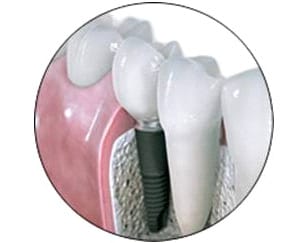
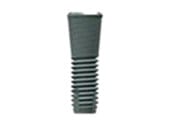
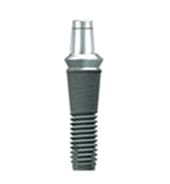
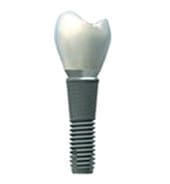

A dental implant is the optimal solution if one or more teeth are missing. The Astra Tech Implant System™ can be tailored to different needs so that virtually anybody can have a tooth replacement that looks and functions like natural teeth. Fully developed bone tissue, however, is an important prerequisite. This is why dental implants are normally not installed in people under the age of 18.
When you are ready for a dental implant, you will have a solution tailored to your needs, general state of health and the quantity and quality of your bone tissue. These factors also determine the total duration of the treatment.
To find out if you are an implant candidate and to learn how Astra Tech implants can help restore the beauty of your natural teeth − speak with your dental professional today.

When you choose dental implants from Astra Tech you have the reassurance of predictable, reliable, long-lasting results.
Based on years of extensive research we have developed a unique dental implant system that works with the body’s natural healing power. The surface of the implant has been treated to generate more bone and speed up the healing process. The result is a strong, tight connection between the bone and the dental implant. In clinical studies our implant system shows unrivalled long-term results. It is well proven that dental implants from Astra Tech have bone- and gum-stimulating properties and help to maintain healthy bone levels and normal appearance of gums and facial structures
A company in the AstraZeneca Group
Astra Tech is a company in the AstraZeneca Group, one of the world’s leading pharmaceutical companies and we are committed to remaining at the forefront when it comes to advanced research and development in the field of implant dentistry.
The Astra Tech Implant System™ is exceptionally well documented and one of the fastest growing systems in the world today.
Astra Tech Implant System™ works together with nature in supporting the natural healing process instead of interfering with it. Healthy gums and maintained bone levels are crucial for a long lasting esthetic tooth replacement. Under the right conditions, nature itself does the major part of the job. The Astra Tech Implant System™ is designed to provide nature with the right conditions; all of the system's parts work together. It is function, beauty and biology in perfect harmony – we call it the Astra Tech BioManagement Complex™.
The Astra Tech BioManagement Complex™ is unique to dental implants from Astra Tech and includes:


Can you really implant happiness? Sometimes, a small piece of titanium can revitalize your smile and boost flagging self-confidence.
Those who have one or more missing teeth may feel insecure and self-conscious, but there is a story behind every missing tooth: an accident or bad genes, perhaps, or maybe cavities or periodontitis are the cause of a gap.
Whatever the reason, patients want to be able to chew properly, to experience reliable stability, to retain their healthy teeth and to feel attractive.
Dental implants: an esthetic long-term solution *

1. An esthetic solution

2. More to enjoy
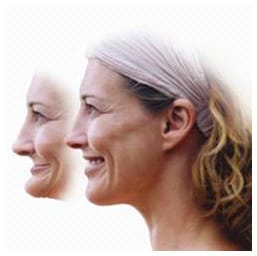
3. Bone preservation
Implants transmit chewing forces to the jaw bones, which helps to maintain the bone. If there is no implant, as with conventional bridges or partial prostheses, the bone may slowly recede and the shape of the face may change over time.
4. Tooth preservation
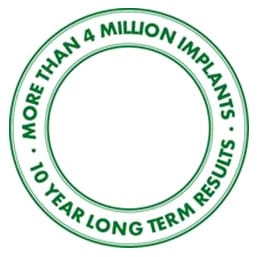
5. Proven quality
Straumann dental implants have been sold over four million times worldwide. The Straumann® Dental Implant System is one of the most frequently used systems in the world and is the result of more than 30 years of scientific experience.
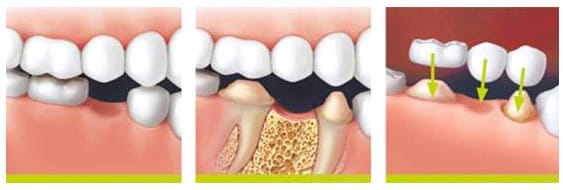
With conventional methods, the two healthy neighbouring teeth have to be ground down in order to fix a bridge in place. This results in a loss of natural tooth surface. Because the bridge does not transmit chewing forces to the jaw bone, bone deterioration may occur.

The dental implant replaces the missing tooth root. The healthy neighbouring teeth remain completely intact and are not ground down.
WHY STRAUMANN?
Straumann, the company
Who we are, what we do, what makes us stand out
Swiss quality with international research

Straumann offers solutions for a wide range of dental indications, from single gaps to completely edentulous jaws. Straumann is one of the global leaders in implant and restorative dentistry and oral tissue regeneration. In collaboration with leading clinics, research institutes and universities, Straumann researches and develops implants, instruments, CADCAM prosthetics and tissue regeneration products.
Straumann is an international group of companies with headquarters in Basel and distributes its products globally in more than 60 countries. Its philosophy? Simply doing more. The company offers innovative solutions which allow dentists to provide their patients with solutions based on the latest research. Reliability and quality are company hallmarks: Straumann solutions are thoroughly researched and scientifically proven –both now and in the future.

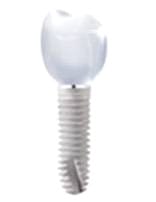
XiVE is designed for the greatest possible prosthetic and surgical flexibility. The multifunctional components allow you to take advantage of all the options available with the innovative prosthetics. For example, with the unique TempBase design from XiVE a temporary denture – virtually the same as the final restoration – is easily fabricated, the ceramic CERCON abutments offer outstanding esthetics, and with a cast-to abutment like the AuroBase even difficult initial situations can be given a functional customized prosthetic solution from the top face of the implant. These prosthetic concepts have been the fist choice of dental technicians, implantologists and patients throughout the world for many years. Implantological choices for you – the best solution for your patients.
Stable, secure and if necessary immediate? This is easy for the specialized implant and thread design of XiVE: the screw implant is a perfect fit in the bone. And in all bone classes. The result is very high primary stability – the decisive prerequisite for successful therapy and implementation of the latest implantology concepts.


